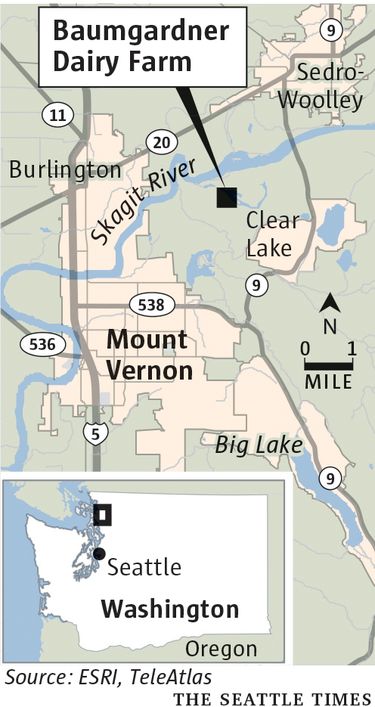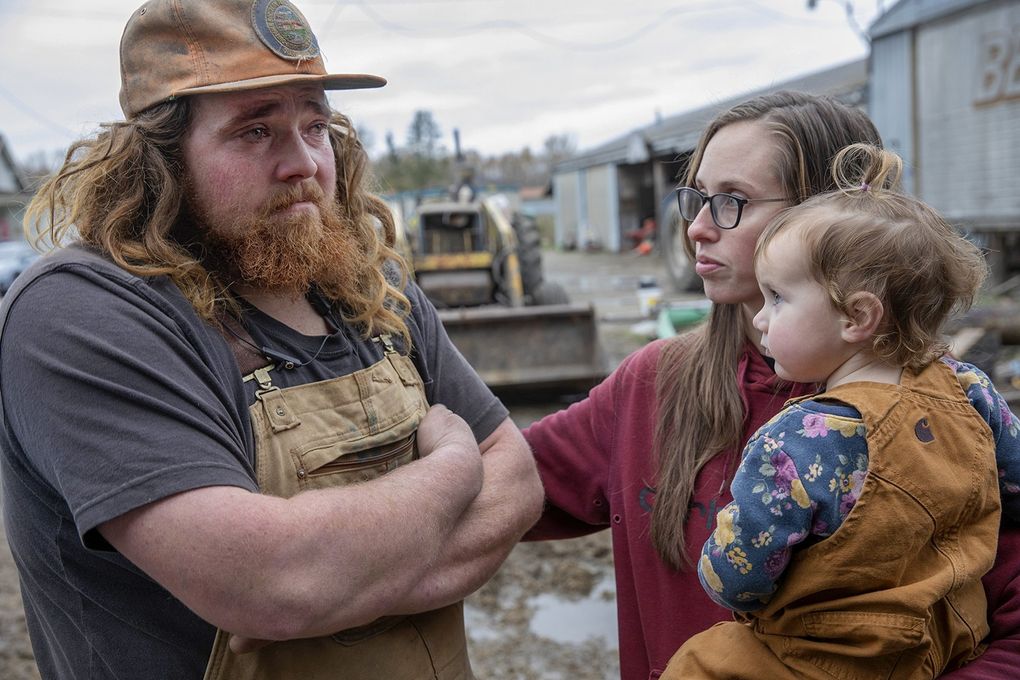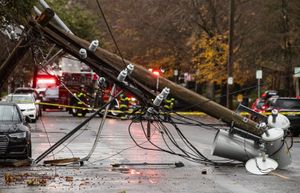‘Unimaginable:’ Mount Vernon dairy farmers reeling from flood devastation
MOUNT VERNON — The Baumgardner family knows the risks of flooding well.
Their sprawling Baumgardner Dairy Farm sits just south of the Skagit River, which is so routinely swollen by rainwater and snowmelt that the nearby city of Mount Vernon built a floodwall. So as the rain kept falling hard the night of Nov. 14 and the Baumgardners herded their cows to fenced “critter pads” on higher ground, everything looked wet but normal, said Jordan Baumgardner, who helps manage the dairy farm owned by his father, David Baumgardner.
But the resulting flood proved to be unlike any other the family had experienced at the farm. The flooding claimed the lives of 44 cows the family had nurtured and watch grow up, and left behind extensive damage they are still trying to assess.
“I carried every single one in my arms at some point when they were born,” Jordan said. “All the cows were born on this farm, which makes the tragedy all that greater.”
The extent of damage from the near-record flood for dairy farmers in Skagit and Whatcom counties may not be known for months, said Dan Wood, executive director for the Washington State Dairy Federation. But the Baumgardner Dairy Farm, one of about 100 dairy farms in the two counties, appears to be the hardest hit, he said.
In the middle of all the devastation, community members have stepped up to offer resources and help to the neighbors affected by the flooding, Wood said.
“Creatures of habit”
The Baumgardner family had prepared their farm the weekend before the Skagit River was expected to crest on Nov. 16 in Mount Vernon as an atmospheric river with its heavy rains washed over the Puget Sound region.
“It’s a giant undertaking,” said Lucinda, David Baumgardner’s wife. The family had to clear up items from the basements in the property’s two homes in case they flooded, as well as secure their 500 or so milking cows, heifers and calves, and their feed.
David Baumgardner bought the dairy farm in 1996.

David made sure the high-ground critter pads where the family’s cows, calves and heifers would stay during the flooding were prepared, and he purchased extra feed for the animals just in case, he said.
There were three layers of protection for the cows, David said. Keeping the cows inside the “critter pads” was an electric fence surrounded by barbed wire and steel panels.
Before dawn, Jordan answered a call from his father, who said the cows were no longer in the critter pads. Jordan raced outside and stumbled into icy water that was 4 feet high and only saw two cows from the 250 still on one critter pad.
“This flood made the previous floods look like nothing,” Jordan said.
The rising water had apparently caused the electric fence to short circuit, making it easier for the cows to break out of the pads as they felt the urge to return to the barn to be milked as was routine.
“They’re creatures of habit,” Jordan said.
Jordan and his brother spent over three hours in chest-deep water with hip and chest waders trying to get every single cow out. The whole family was in and out trying to get the cows out from the flooded area and back to the high ground until it became too unsafe.
“Some people may say your life isn’t worth any amount of cows, but I was willing to try and get close to saving them all,” Jordan said. But there was a point where the water was far too deep for anyone to wade through safely.
“It was tough to leave them,” he said.
The current was strong enough to knock over Jordan’s sister, Shayleigh Baumgardner, 19, as she tried to make her way down to the stalls. She was able to hold onto a fence and make her way back to shallower water.
It was as terrifying for her as it was for her mother, Lucinda, who had watched Shayleigh get swept into what looked like a whirlpool.
“We had each other, which made the situation a little easier,” Shayleigh said. The next morning Shayleigh woke up to bake chocolate chips cookies to try to lift everyone’s spirits.
“I think it worked a little,” she said.
A family endeavor
The Baumgardner family is still picking up the damage left behind.
Jordan, like many of his nine siblings, started helping out on the family farm as soon as he could walk, he said. But it wasn’t until he was around 15 that he took on full-fledged responsibilities. Now at 31, he is the herdsman and co-manages the dairy farm alongside his father.
In addition to Jordan, Jacob and Shayleigh, all siblings, also work around the farm, Lucinda said. The Baumgardners also have three full-time employees, who feel like family.
David said he still feels a tremendous sense of guilt over the loss of 44 cows. While 42 cows drowned, one was seriously injured and had to be put down while another fell violently ill and died. Every cow can be traced back to the original 20-head herd David purchased around 1980.
These cows are important to the family, not just because they help support the family business. David said they view each cow as an individual, with its own personality and temperament.
“A lot of our animals are just like great big dogs,” David said. “They belong here and we care for them.”
Hard to look
Even now, it’s hard for Lucinda to look at the damage the flood left behind in her home.
“It’s unimaginable, the damage water can cause,” she said
The flooding in the farm was 5 inches higher than any previous flood the family or any other farmer in that area had experienced, David said. The water level mark in the workshop is a full 5 inches higher than the mark left behind by the record 1990 flood the previous owner traced.
The trio of Skagit River dams absorbed a “significant part of the flood,” but officials had to release some of the water because the reservoirs were full, according to the National Weather Service. The dam discharge was not expected to create additional flooding, officials said.
“With the previous floods, there was a sense that you were sitting in the middle of a big lake,” David said. “This flood had a driving current flowing through.”
The cows weren’t milked for 56 hours, Lucinda said. A whole week’s worth of milk had to be thrown out, which cost the farm $20,000 dollars. The cows are still producing about half of what they usually do, which will go on for quite some time.
“We’re trying to stay optimistic because we still have to go on,” David said.
The support coming from the community has been overwhelming, David said. Other farmers stepped up to help remove the dead livestock, aided in the cleanup and offered to donate feed.
“We usually have the mentality that this is just another knock that we’re gonna have to take and it hasn’t wound up being that way,” he said.
But a neighbor set up a GoFundMe page for the family to assist them with the costs of damage. The page was a few thousand dollars shy of reaching its $52,000 goal Friday evening.
The family is still getting about 400 stalls cleaned up and working to get fresh bedding for the cows, David said.
The main focus is on taking care of all the animals, getting them clean and dry, David said.
Long road to recovery
Though not all dairy farms in the Whatcom County and Skagit area were flooded, there were concerns about potential feed disruption after the largest feed mill in the region, EPL Feed in Sumas, Whatcom County, was flooded and electronics were damaged, said Wood with the Washington State Dairy Federation.
The mill supplies feed for about 100,000 milking cows in Western Washington, but was unable to produce feed for over a week, he said. About two to three days ago, EPL was able to resume making feed, but is still not producing farm-tailored feed like it usually does.
In the meantime, other farmers stepped up to donate feed directly to dairy farmers or made donations to the federation to help address that, he said.
The rail line in Sumas had 15 breaks, which was disrupting the supply chain. Those are all fixed now or at least close to being fixed, Wood said.
Beyond the dairy farms, 1,200 people were displaced from their homes in Sumas alone.
“It’s tough when you see a storm like this hit and things happen that haven’t happened to folks in particular areas, but you see the humanity come out where folks are helping each other out, and that’s pretty amazing,” Wood said.
Daisy Zavala: dzavala@seattletimes.com; on Twitter: @daisyzavv.







No comments:
Post a Comment